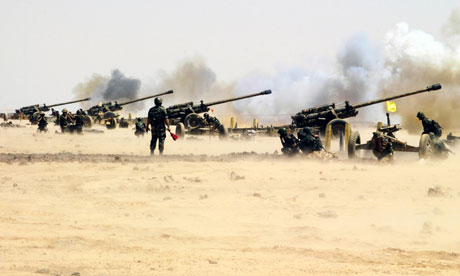
Syria: government troops participate in a live fire exercise. Photograph: AP
UN observers are expected to return to Tremseh today, AP reports, bringing hope they may be able to shed new light on the events of Thursday night.
The wire's latest dispatch has this take on the UN's statement last night.Some of the emerging details suggested that, rather than the outright shelling of civilians that the opposition has depicted, the violence in Tremseh may have been a lopsided fight between the army pursuing the opposition and activists and locals trying to defend the village.Nearly all of the dead are men, including dozens of armed rebels. The U.N. observers said the assault appeared to target specific homes of army defectors or opposition figures.Running tolls ranged from around 100 to 152, including dozens of bodies buried in neighboring villages or burned beyond recognition. The activists expected the number to rise since hundreds of residents remain unaccounted for, and locals believe bodies remained in nearby fields or were dumped into the Orontes River.
What actually happened in Tremseh remains "murky", the New York Times says, adding that evidence available suggests events "more closely followed the Syrian government account" than that of opposition activists.
The Syrian government has today dismissed the reports of a massacre, rejecting special envoy Kofi Annan's claims that heavy weapons and helicopters were used in clashes. AP reports:
Jihad Makdissi, a spokesman for the Foreign Ministry, said security forces killed 37 fighters and two civilians in a campaign against the town, from which the government said rebels were launching attacks on other areas."Government forces did not use planes, or helicopters, or tanks or artillery. The heaviest weapon used was an RPG (rocket propelled grenade)," Makdissi t o ld reporters at a news conference in Damascus."Yesterday we received a letter from Mr. Kofi Annan addressed to the Foreign Minister Walid al-Moualem. The least that can be said about this letter about what happened in Tremseh is that it did not rely on facts. As diplomatically as possible, we say that this letter was very rushed."
Justifying its belief that the government's version of events looks likely to be the more truthful, the New York Times details the new claims of the UN, as well as uncertainty over the death toll. It concludes:
In previous massacres, however, like the one in Houla in late May, there was the immediate synchronization between the long lists of civilian names, the gruesome videos of dead women and children, and corroboration by United Nations observers who faulted the Syrian Army for using tank shells and other heavy weaponry against a civilian area. That is missing in the case of Tremseh.
The Guardian's Martin Chulov has written a wrap-up of the situation as it currently stands here.
The main points are as follows:
• Late last night, the UN monitoring mission released a statement saying that the military attack on Tremseh appeared to have mainly targeted guerilla forces and their supporters. It said:
The attack on Tremseh appeared targeted at specific groups and houses, mainly of army defectors and activists.
• Of 103 fatalities recorded by opposition sources, all are male. Chulov says this is "a fact that adds weight to the view that fighting-aged males were at least partly targeted during the assault."
• However Chulov has himself spoken to local residents who insist they were all targets of a bombardment which involved mortars, artillery and helicopters. They claim that close to 150 people from the town are either dead or missing.
In his report for the Observer today, Chulov quotes one resident of Tremseh as saying:
The bombardment started at 5.30am and ended at 2pm. The incursion started at midday from the north of the village. Shabiha and regime military men entered the village and occupied the roofs of high buildings and shot at anything moving.They shot many civilians in the head and then burned the bodies. They handcuffed civilians and then shot them in the head. They burned shops and houses with families inside. After what happened, the FSA [Free Syrian Army] members tried to get inside the village to help with burying the martyrs and tending to the wounded but they couldn't.The criminals took many martyrs' bodies and wounded civilians with them and there are many missing people and burnt dead bodies with no way to identify them.
Good morning. There is uncertainty today over what precisely happened in the small Syrian town of Tremseh on Thursday night.
While reports from locals and opposition activists indicate that more than 150 died during a brutal massacre by regime thugs, or shabiha, UN observers on the ground have now said evidence they have seen points towards a clash between the heavily-armed army of Bashar al-Assad and local opposition fighters.
There is also apparent uncertainty over the death toll.
Claims and counter-claims, rumour and speculation abound. We'll be updating this blog throughout the day as more information emerges.
